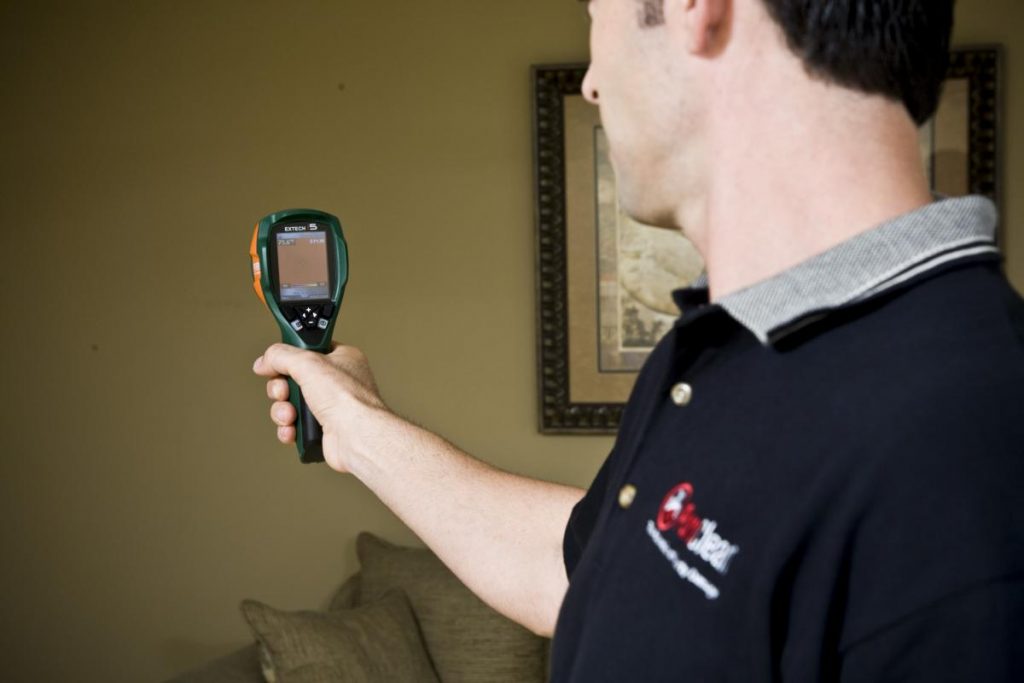 Drying Inside The Wall
Drying Inside The Wall
Water intrusion and plumbing leaks can leave property owners with wet walls – and insurance professionals with claims. A key question arises: is it necessary to remove the wall?
In the past, restoration practices called for the complete removal and replacement of wet drywall or other wet materials from walls. Today’s technology, however, allows our restoration professionals at PuroClean Certified Restoration many water removal options to save walls – significantly reducing restoration costs.
When health and safety are at risk, industry standards require the removal of porous wall materials. This will be the case when sewage or floodwaters have entered the home. In addition, drywall should be removed and replaced when structural integrity is lost. There is no need to spend time and effort to dry those materials. Instead, they should be removed at the beginning to reduce drying times. In most other cases, however, saving the wall is possible. Our skilled restorers will apply the appropriate techniques, depending on the construction materials of the wall.
A most common obstruction to effectively drying walls is a vapor barrier. A vapor barrier is any materialthat impedes the evaporation of moisture from walls or other materials. It can include gloss paint, vinyl wall covering, Tyvek® house wrap, plastic sheeting or other impermeable materials.
In some situations, simply removing the outer vapor barrier quickly promotes the drying process. Vinyl wall covering, typically used in kitchens and bathrooms, can easily be removed. Perforating gloss or semi-gloss paints helps release moisture from the wall material.
If building materials are wet on both sides of an impermeable or semi-permeable material, the only option may be the removal of some or all of the wall components until the remaining materials are able to dry.
Another common impediment to drying is insulation. A wall may contain fiberglass (with or without backing material), spray foam, or blown-in insulation. Each of these materials presents its own special needs in the drying process.
Blown-in fiberglass or cellulosic insulation can compact and move down the wall cavity when it becomes wet. After compression occurs, the insulating properties of the material are lost and cannot be restored. If this is the case, the insulation will need to be removed and then replaced after the wall is dry.
Fiberglass insulation with paper backing can, in most situations, be successfully dried, using air injection or other methods. Sprayed-in or expanding foam insulation creates a very effective vapor barrier that normally needs to be removed.
In some situations it is possible to successfully dry if both sides of an interior wall are accessible, or if an exterior wall is only wet on the interior side. Plaster walls present a unique challenge. They dry much slower than gypsum drywall, but the price to replace plaster is quite high. Therefore, drying is usually a more cost-effective and better option than removal.
Special techniques such as tenting and low-grain dehumidification are used to effectively dry plaster walls. Raising the temperature of the room also speeds the drying process. A wall built with metal studs presents another challenge. The bottom frame of the wall system is a C-shaped metal channel with the opening facing up. This channel collects and retains water. Excess water will need to be vacuumed out of the channel to expedite drying.
Drying can be hastened by drilling small holes along the bottom of the wall. Injector nozzles are inserted and air is introduced into the wall cavity, greatly reducing drying time. When the drying is complete, these holes are patched or covered by baseboard. This process is faster and less expensive than removing and replacing walls.
Our PuroClean Certified Restoration professionals use principles such as equilibrium drying, capillary action, vapor pressure differentials, grain depression, psychrometrics, laminar airflow, and boundary layer movement to efficiently and effectively dry wet walls. The process may include injection drying to put dry air inside walls, tenting to reduce the amount of wet air in the affected area, or managing the environment to promote effective drying solutions.

